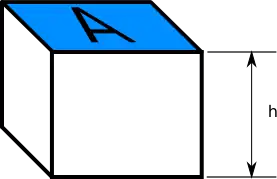Prisms
An n-sided prism is a polyhedron made of an n-sided polygonal base, a translated copy, and n faces joining corresponding sides. Thus these joining faces are parallelograms. All cross-sections parallel to the base faces are the same. A prism is a subclass of the prismatoids.
The volume of a prism is the product of the area of the base and the distance between the two base faces, or height. In the case of a non-right prism, the height is the perpendicular distance.

In the following formula, V=volume, A=base area, and h=height.
The surface area of a prism is the sum of the base area and its face, and the sum of each side area, which for a rectangular prism is equal to:
-
- where l = length of the base, w = width of the base, h = height
Pyramids
The volume of a Pyramid can be found by the following formula:
- A = area of base, h = height from base to apex
The surface area of a Pyramid can be found by the following formula:
- = Surface area, = Area of the Base, = Perimeter of the base, = slant height.
Cylinders
The volume of a Cylinder can be found by the following formula:
- r = radius of circular face, h = distance between faces
The surface area of a Cylinder including the top and base faces can be found by the following formula:
- is the radius of the circular base, and is the height
Cones
The volume of a Cone can be found by the following formula:
- r = radius of circle at base, h = distance from base to tip
The surface area of a Cone including its base can be found by the following formula:
- is the radius of the circular base, and is the height.
Spheres
The volume of a Sphere can be found by the following formula:
- r = radius of sphere
The surface area of a Sphere can be found by the following formula:
- r = radius of the sphere
Navigation
- Geometry Main Page
- Motivation
- Introduction
- Geometry/Chapter 1 Definitions and Reasoning (Introduction)
- Geometry/Chapter 1/Lesson 1 Introduction
- Geometry/Chapter 1/Lesson 2 Reasoning
- Geometry/Chapter 1/Lesson 3 Undefined Terms
- Geometry/Chapter 1/Lesson 4 Axioms/Postulates
- Geometry/Chapter 1/Lesson 5 Theorems
- Geometry/Chapter 1/Vocabulary Vocabulary
- Geometry/Chapter 2 Proofs
- Geometry/Chapter 3 Logical Arguments
- Geometry/Chapter 4 Congruence and Similarity
- Geometry/Chapter 5 Triangle: Congruence and Similiarity
- Geometry/Chapter 6 Triangle: Inequality Theorem
- Geometry/Chapter 7 Parallel Lines, Quadrilaterals, and Circles
- Geometry/Chapter 8 Perimeters, Areas, Volumes
- Geometry/Chapter 9 Prisms, Pyramids, Spheres
- Geometry/Chapter 10 Polygons
- Geometry/Chapter 11
- Geometry/Chapter 12 Angles: Interior and Exterior
- Geometry/Chapter 13 Angles: Complementary, Supplementary, Vertical
- Geometry/Chapter 14 Pythagorean Theorem: Proof
- Geometry/Chapter 15 Pythagorean Theorem: Distance and Triangles
- Geometry/Chapter 16 Constructions
- Geometry/Chapter 17 Coordinate Geometry
- Geometry/Chapter 18 Trigonometry
- Geometry/Chapter 19 Trigonometry: Solving Triangles
- Geometry/Chapter 20 Special Right Triangles
- Geometry/Chapter 21 Chords, Secants, Tangents, Inscribed Angles, Circumscribed Angles
- Geometry/Chapter 22 Rigid Motion
- Geometry/Appendix A Formulae
- Geometry/Appendix B Answers to problems
- Appendix C. Geometry/Postulates & Definitions
- Appendix D. Geometry/The SMSG Postulates for Euclidean Geometry